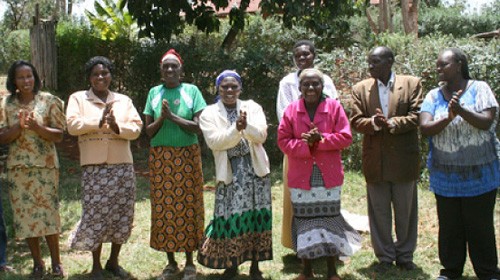Home » Green Belt Movement Revives Watershed in Kenya

CELEBRATING TREES: Grace Wanjiru, (second to the left) Chair of the Githakwa PLWAS (People Living with AIDS) Needy Guardian Self Help Group, and fellow group members sing and dance when a seedling is planted.
Amy Gambrill
In the Chania watershed on the eastern side of the Aberdare forest in central Kenya, Grace Wanjiru waters a seedling in the Githakwa PLWAS (People Living with AIDS) Needy Guardian Self Help Group nursery. Her simple act of planting trees with the Green Belt Movement is having an enormous impact on the degraded ecosystem, the water supply for bustling Nairobi, and the place of women in the community.
Since 1977, Nobel Peace Prize Winner Wangari Maathai has led small groups of women to address their lack of firewood and access to clean water by growing trees on their farms, often with USAID support. The growing movement gave women a reason to come together and become involved in resolving their communities' challenges. Today, 90% of the members are women.
The women of the Nyeri in the central province have established more than 316 tree nurseries, with a combined production of 1.5 million seedlings per season since USAID began supporting the Aberdare Reforestation Project in 2008. Now, more than 2,000 women members of the Tetu constituency learn about local trees, collect seeds, and grow seedlings in community nurseries. "The community can see the trees as resources: wood, cover, shade, fruit. And because of Green Belt's efforts, the communities appreciate a tree," said Professor Karanja, CEO of the Green Belt Movement in Nairobi, Kenya.
Green Belt provides the community groups with environmental education, training in proper planting techniques, and advice on where to plant: on farms, at schools, and in public spaces. Member groups can earn as much as $5,000 per year from Green Belt compensation and the selling of tree seedlings directly to conservation NGOs, private companies, and farmers. Since 2008, nearly two million trees have been planted along riparian areas, public lands, and on farms, improving 1,700 hectares of previously degraded land.
Because of the deforestation, natural springs that fed the Chania River dried up, making the river's water levels very low. The reforestation efforts of the women in the watershed have led to the rejuvenation of 65 springs. And the microclimate is enhanced in the planted areas: "We have noticed more rain since we planted the trees. When I came in 2008, you could walk across the river; now, it is almost back to historic levels," said Joyce Nyambura, a Green Belt Movement Extension Officer.
Interview with Chairwoman Grace Wanjiru, Githakwa Nursery
USAID-Supported Gakanga Reforestation Site
Tetu Constituency, Central Kenya
How did you get started with Green Belt Movement?
In 2006, four groups joined together—widows, guardians of children orphaned by HIV/AIDS, and people living with HIV/AIDS. We saw fit to join together because we had issues and problems that were similar. The group has 25 members.
I am one of the guardians in our group. I look after children who were left behind by my brother and his wife. In the initial stage, we started meeting in my home, and that's where the Green Belt Movement idea came from. Green Belt Movement mostly works with women's groups, and since we were already established, we decided to join. In 2008, we decided to start tree nurseries to help us with our challenges.
Where do you plant the trees?
We grow them in our nursery first, and then we plant them in the public forest. I have also gone to secondary schools to start up tree nurseries. There are already 2,000 seedlings in the nursery at St. Paul's School. And now we want to go to primary schools to preach the three ideas: trees, water, and food. We tell them the importance of doing the three things at one time.
How does Green Belt Movement help women?
Green Belt Movement helps us come together. Green Belt Movement restores our environment. The compensation from Green Belt has greatly helped our households because we can also get help from other donors. It has empowered women. I can raise seedlings in my own house.
Now I am able to attend the public barazzas—meetings with the chief. I have to present Green Belt. I would not go to these meetings if I weren't in Green Belt.
We mostly deal with people who have financial difficulties. The women have the knowledge, but they don't have people to boost them. People can do a lot of things if they have the motivation. It's just financial constraints that affect them.
What does your group do with the compensation?
We realized we could help needy children. We were able to pay for medicine for those who had given up on taking their HIV medicine or stopped taking it. And now we have added food security initiatives and water harvesting at the household level. We are planting arrowroot along our house so the rainwater that comes off the roof isn't wasted. We advocate for growing organic, indigenous foods because they are healthier for women who are sick. Whatever we do on our demonstration farm can be repeated on all farms locally.
Have you noticed a difference in the amount of water available since Green Belt Movement came here?
We noticed that since we planted trees on public lands, we see water in the form of rains. There was a time that was very dry, especially 2008. The rivers had dried up that year, so at least now we are starting to see the changes after planting trees there.
How are women and water linked?
Women have problems when it comes to water. Women waste a lot of time and energy in search of water, and that affects women's work in the home and other duties she might have. When women are supported, we can do big, amazing things.
A. Gambrill
For more information, visit:







Comment
Make a general inquiry or suggest an improvement.